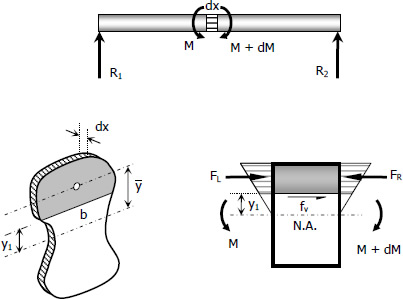Shear Flow
Shear Flow
If the shearing stress fv is multiplied by the width b, we obtain a quantity q, known as the shear flow, which represents the longitudinal force per unit length transmitted across a section at a level y1 from the neutral axis.
- Read more about Shear Flow
- Log in to post comments
Solution to Problem 559 | Built-up Beams
Problem 559
A beam is composed of 6 planks, each 100 mm wide and 20 mm thick, piled loosely on each other to an overall dimension of 100 mm wide by 120 mm high. (a) Compare the strength of such a beam with that of a solid beam of equal overall dimensions. (b) What would be the ratio if the built-up beam consisted of a 12 planks each 100 mm wide by 10 mm thick?
Solution to Problem 558 | Unsymmetrical Beams
Problem 558
In Prob. 557, find the values of x and wo so that wo is a maximum.
- Read more about Solution to Problem 558 | Unsymmetrical Beams
- Log in to post comments
Solution to Problem 557 | Unsymmetrical Beams
Problem 557
A cast-iron beam 10 m long and supported as shown in Fig. P-557 carries a uniformly distributed load of intensity wo (including its own weight). The allowable stresses are fbt ≤ 20 MPa and fbc ≤ 80 MPa. Determine the maximum safe value of wo if x = 1.0 m.
- Read more about Solution to Problem 557 | Unsymmetrical Beams
- Log in to post comments
Solution to Problem 556 | Unsymmetrical Beams
Problem 556
A T beam supports the three concentrated loads shown in Fig. P-556. Prove that the NA is 3.5 in. above the bottom and that INA = 97.0 in4. Then use these values to determine the maximum value of P so that fbt ≤ 4 ksi and fbc ≤ 10 ksi.
- Read more about Solution to Problem 556 | Unsymmetrical Beams
- Log in to post comments
Solution to Problem 555 | Unsymmetrical Beams
Problem 555
A beam carries a concentrated load W and a total uniformly distributed load of 4W as shown in Fig. P-555. What safe value of W can be applied if fbc ≤ 100 MPa and fbt ≤ 60 MPa? Can a greater load be applied if the section is inverted? Explain.
- Read more about Solution to Problem 555 | Unsymmetrical Beams
- Log in to post comments
Solution to Problem 554 | Unsymmetrical Beams
Problem 554
Determine the maximum tensile and compressive stresses developed in the overhanging beam shown in Fig. P-554. The cross-section is an inverted T with the given properties.
- Read more about Solution to Problem 554 | Unsymmetrical Beams
- Log in to post comments
Horizontal Shearing Stress
Let us consider a differential length dx of the beam shown

For the upper shaded portion of the beam, the forces acting are the total normal forces FR and FL due to the bending stresses to the left and to the right of the beam. These forces will be resisted by the shearing force fvb dx acting at the boundary surface between the shaded and the unshaded portions.
- Read more about Horizontal Shearing Stress
- Log in to post comments
Superimposed or Built-up Beams
If a beam is composed of two or more thin layers placed on each other without any attachment, the separate layers would slide past each other and the total strength of the beam would be the sum of the strengths of the various layers. The strength of this beam is lesser than a solid beam having the same cross-sectional area.
- Read more about Superimposed or Built-up Beams
- Log in to post comments
Solution to Problem 553 | Unsymmetrical Beams
Problem 553
Determine the maximum tensile and compressive bending stresses developed in the beam as shown in Fig. P-553.
- Read more about Solution to Problem 553 | Unsymmetrical Beams
- Log in to post comments

Recent comments
(…